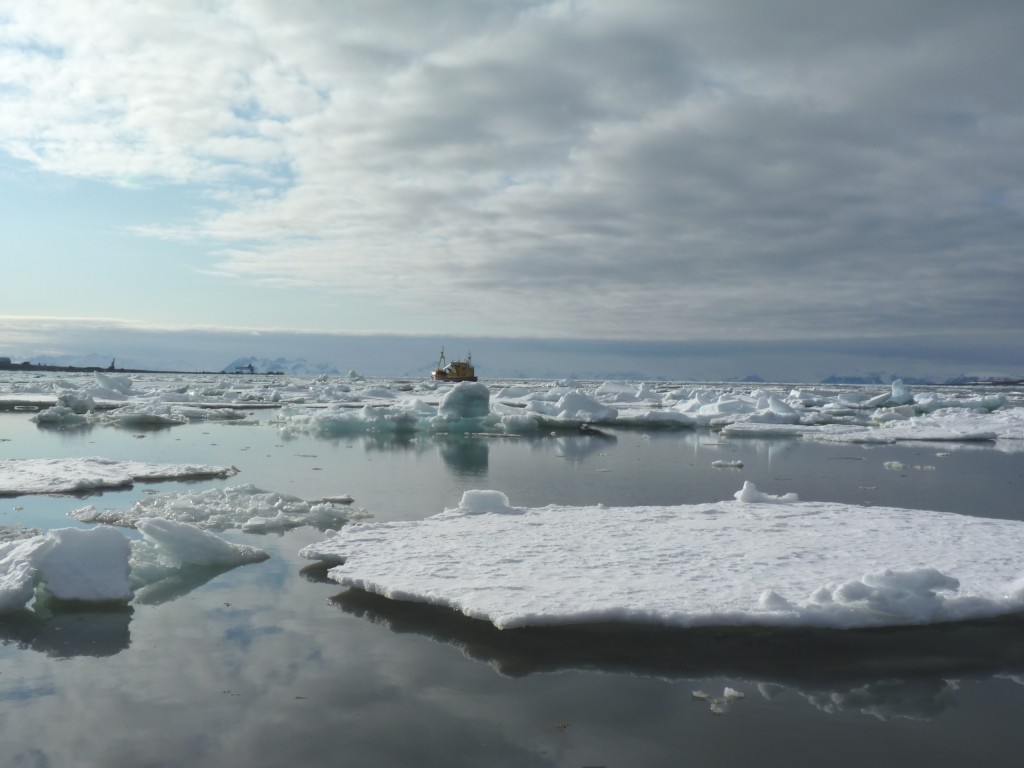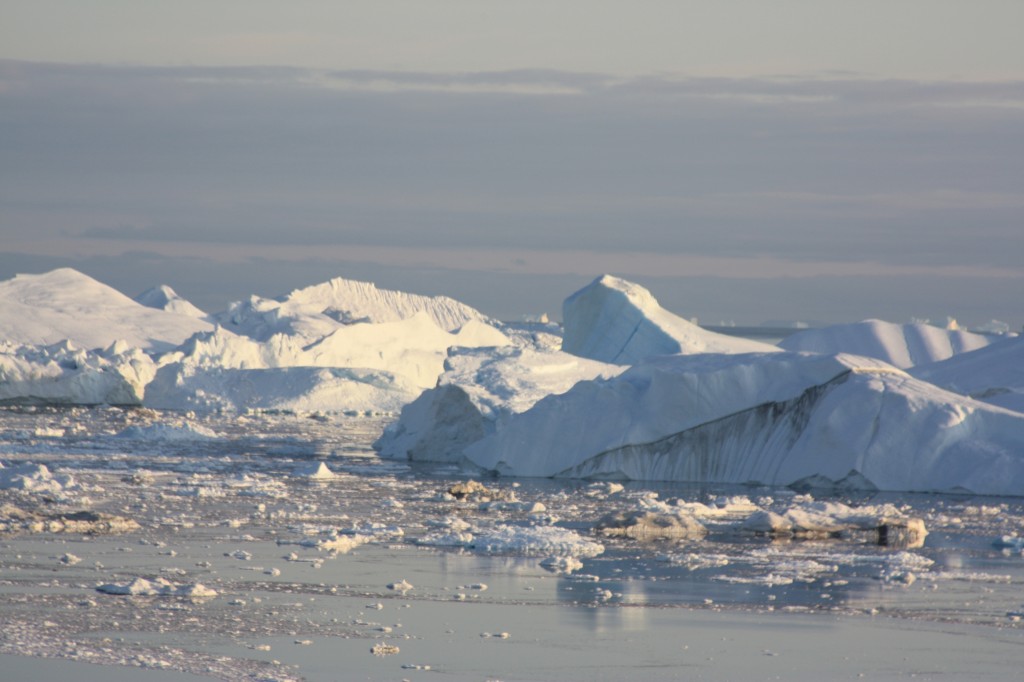Search Results for Tag: Oil
Arctic melt worries UN and White House
The UN weather agency WMO (World Meteorological Organisation) has confirmed that the Arctic’s sea ice melted at a record pace in 2012, the ninth-hottest year on record. With just 3.4 million square kilometres (1.32 million square miles) during the August to September melting season, the sea ice cover was a full 18 percent less than the previous low set in 2007. The WMO’s Secretary-General Michel Jarraud said this was a “disturbing sign of climate change”, and pointed to the link between climate change and extreme weather events.
Meanwhile, a special briefing was called at the White House to discuss the possibility of the Arctic becoming ice free in the summer within just TWO years. Nafeed Ahmed, director of the “Institute for Policy Research & Development” headlines his post for the “Guardian“: “White House warned on imminent Arctic ice death spiral”. He describes the meeting, including NASA’s acting chief scientist Gale Allen, the director of the Department of Homeland Security and the Pentagon as “the latest indication that US officials are increasingly concerned about the international and domestic security implications of climate change”.
10 Arctic specialists were called in to advise the US government, including marine scientist Professor Carlos Duarte, currently director of the Oceans Institute at the University of Western Australia. I met and interviewed Prof. Duarte back in 2011 at the Arctic Frontiers conference, when he worked with the Spanish Council for Scientific Research. At that time, he was already calling for urgent action and warning of the danger of “climate tipping points”, including the melt of the Arctic sea ice. His conclusions are based on research which was presented in an article in Nature Climate Change last year.
The West Australian newspaper quotes Prof. Duarte as saying the “snowballing situation would prove as hard to slow down as a runaway train”. He told the paper the ice melt was accelerating faster than any of the models could predict, and the prospect of an Arctic Ocean free of ice had been brought forward to 2015, compared with a prediction in 2007 that at least a third of the normal sea ice extent would remain in summer in 2100. When I spoke to him in 2011, the US navy was already assuming a date of 2050 and Duarte said he expected it to be even earlier.
Professor Carlos Duarte on Arctic Tipping Points
Prof Duarte also warned of the increasing danger of melting methane. Let me quote a little from the interview:
DUARTE: “We know from the history of ice covering the planet along geological time scales that ice is strongly a non-linear element in the earth’s system. It’s one of the components that show very rapid, very abrupt changes and tipping points. So we expect that once the ice will be lost quickly from the Arctic and also from the shelves in Greenland, then other forces will be set in motion, and many forces will be set in motion by loss of ice. One of them is the release of methane hydrates from the shallow continental shelves, mostly around Siberia, and those are molecules of methane that are trapped into ice in the sediments of the continental shelves and in the permafrost on land. So if this ice melts, this methane can be released abruptly and suddenly. And deposits of methane trapped in the shallow sediments of the Arctic amount to about five times the greenhouse power that humans have set in motion through burning fossil fuels. So if this five times what we have released in 150 years is released within a few years, that would be detrimental to the climate system and it could lead to a very rapid warming, and could again set in motion other forces like increased freshwater discharge to the Arctic, which has already increased by 30 percent. And this involves a greater export of fresh water and buoyancy to the Atlantic, which may affect global circulation and global currents, and those in turn will affect regional climates also further south to the sub-Arctic region. Also, warmer temperatures are leading to dieback of the boreal forest and also the peat deposits in the boreal region are drying up to the extent that they can catch fire.”
(IRENE QUAILE: How close are we?)
DUARTE: “We very much know what the threshold and the tipping point for the release of methanes will be, because the methane is kept in the hydrates, deposits in the salty sediments by ice, frozen sediments, and we know the freezing point of salty sediments may be around minus 1 degree. So when the temperature of water in the summer goes well above freezing point, the hydrates will defrost and the methane will be released. So what we need to monitor is the temperature of the shallow waters in the Siberian shelf and other shallow waters in the Arctic, in the Canadian region as well, and see how close they’re getting to temperatures of 3 and 4 degrees, which will be those that will lead to melting of the hydrates.”
Scary? The interview, it seems, is as relevant as ever, the Professor’s warnings more urgent. I wonder what it feels like to be called in to the White House to brief the government of a country that is both a key player in the Arctic and a top emitter of the greenhouse gases that are causing the melt? On the one hand it must be satisfying for the scientists to know they are finally being heard. But there must also be some frustration about the extent of dangerous climate change that had to be set in motion first. Has the Arctic ice already reached a “tipping point”?
Let me close with another quote from that interview with Carlos Duarte:
DUARTE: “Unfortunately society is much more mobilised by opportunities than by risks. So the discourses and warnings of risks actually almost lead to inaction by society, whereas the sight of opportunities encourages society to set themselves in motion. So the opportunities for economic growth in the Arctic have dominated the discourse and the actions by society and policy makers. Those opportunities are new navigation routes across the Arctic, and the exploitation of oil, gas and fisheries, that were not accessible just a few years ago. The paradox in this is that the Arctic countries recognise that the forces that are improving access to these resources is actually climate change and that the reason for this climate change is the burning of fossil fuels by humans. Arctic nations themselves are responsible for 26% of the release of these greenhouse gases and are taking advantage of these opportunities, which will involve greater emissions of greenhouse gases. (…) I think there should be a balance between the economic growth these opportunities could bring about and the economic losses, they may bring about, which I don’t think have been quantified.”
No Arctic Council meeting for Greenpeace North Pole trekkers
A group of young campaigners have been trekking to the North Pole this week, as part of the Greenpeace campaign to “Save the Arctic“. There are 16 people in the group, including four international youth ambassadors : Hollywood actor Ezra Miller, two Arctic Indigenous representatives and a young man from the Seychelles . I was hoping to be able to report here on the Ice Blog that they had met with members of the Arctic Council who were also to visit the North Pole this week. But for reasons yet to become clear, the meeting didn’t happen.
One of the explorers, Josefina Skerk, a 26-year-old member of the Sami Parliament in Sweden, had sent a letter to Gustaf Lind, Swedish chair of the Arctic Council’s Senior Arctic Officials, requesting a meeting with the Arctic officials, when they heard they would be at the North Pole at the same time. Mr. Lind apparently accepted the invitation, but the meeting did not take place. There is an amazing multimedia website for the project, where you can follow the expedition and find out about the trekkers and their motives: Into the Arctic. One of the girls says her hands are freezing but her blood is boiling because the meeting didn ‘t work out. But you can see and hear all that for yourselves on the site.
The activists say “no one nation should own the Arctic or be allowed to exploit the melting Arctic sea ice, a crisis created by climate change, for more of the fuels that caused the melt in the first place”. The trekkers are carrying with them a time capsule that contains a declaration with 2.7 million signatures calling for the Arctic to be made a global sanctuary. Greenpeace says they plan to lower the capsule and a ‘Flag for the Future’ through 4.3 km of freezing water to the seabed beneath the North Pole.
Some of those signatures were collected here in Bonn, as reported on the ice blog and DW radio and online pages at the time:
Russia helps China drill deeper into the Arctic
When the new Chinese President Xi Jinping visited Russia as his first official foreign destination last week, one of the agreements signed on the sidelines was a deal between the Chinese National Petroleum Corporation (CNPC) and Russia’s oil company Rosneft, which paves the way for more exploration in the Arctic. The BarentsObserver says the cooperation makes the Chinese concern Rosneft’s third foreign partner in the Barents Sea. The area in question is located to the west of the archipelago of Novaya Zemlya and to the northeast of Gazprom’s Shtokman field. The BarentsObserver says the most likely option is that CNCP will get a 33 percent stake in a joint venture and bear all costs for initial exploration and drilling. The area is one of the least explored areas on the Russian continental shelf. The hydrocarbon potential is believed to be considerable.
![]() read more
read more
Shell puts Arctic drilling on hold
Shell has said it will not drill for oil in the Alaskan Arctic this year. The announcement was not surprising, as the company is facing official US investigations after a series of problems, culminating in the grounding of the Kulluk drilling ship in a storm late last year. The company announced earlier this month that its two Arctic offshore rigs would be going to Asia for repairs and upgrades. Critics say oil drilling in Arctic regions is too risky and there is not sufficient capacity to cope with an oil accident in the remote region with its extreme weather conditions and fragile ecosystem.
Environment campaigners welcomed the announcement. Reuters quotes Michael LeVine from Oceana in Juneau, Alaska, as saying both Shell and the government agencies regulating the company faced a “crisis of confidence”. He says the decisions to allow Shell to operate in the Arctic Ocean were premature. Phil Radford, Executive Director of Greenpeace USA issued a statement saying:
“Shell was supposed to be the best of the best, but the long list of mishaps and near-disasters is a clear indication even the ‘best’ companies can’t succeed in Arctic drilling. Secretary Salazar and President Obama gave drilling a chance; now the responsible decision is to make Arctic drilling off limits, forever.” Shell has collected more than 2.7 million signatures for their “Save the Arctic” campaign.

I interviewed Greenpeace “Save the Arctic” campaigners including Lukas as they collected signatures in Bonn, Germany, last year.
However, the announcement does not mark the end of Arctic drilling plans. ConocoPhillips reaffirmed on Wednesday that it would continue with its own plans to drill one or two exploration wells in the Chukchi Sea in 2014, and expected to submit more information on it to the federal regulator by the end of March. Marvin Odum, director of Shell Upstream Americas, stressed this was only a temporary break in his group’s Arctic activity: “Our decision to pause in 2013 will give us time to ensure the readiness of all our equipment and people.”
Business opportunities boom in the Arctic
Greenpeace criticizes draft Arctic oil spill response agreement

The symbol of an intact Arctic: A polar bear puts in an appearance on a poster at a Greenpeace “Save the Arctic” stand in Germany.
The Arctic Council environment ministers will be meeting in Jukkasjärvi in Sweden over the next few days. One of the items on the agenda is a long-awaited agreement on dealing with oil accidents in the Arctic. A copy of the document has been leaked, and Greenpeace says it is “vague and inadequate”. “Marine Oil Pollution Preparedness and Response in the Arctic” is the title of the paper, set to be adopted by the Council’s foreign ministers at their meeting in May. An oil spill in the Arctic would be very hard to tackle for various reasons, including remoteness, cold, ice, darkness and the fact that oil takes longer to break up in cold conditions. Remember the Exxon Valdez? If you are young enough not to, it was a tanker that went down in Prince William Sound in 1989, with devastating effects on the environment.. I visited the spot a couple of years ago, and there are still clumps of oil under stones on the beaches. And of course Shell is having its own problems with Arctic drilling at the moment.
Greenpeace is running an international campaign against oil drilling in the Arctic. Ben Ayliffe, head of the campaign, told the media: “This draft agreement does not inspire confidence in the ability of the Arctic Council to protect this fragile region when the worst happens. It’s incredibly vague, it fails to hold oil companies liable for the impact of their mistakes, and there is nothing here that ensures adequate capacity to deal with a spill in these nations”
I have been talking to a lot of experts on this over the last few years and most of them are convinced that a spill would happen sooner or later and would be extremely difficult to deal with. The risks to the fragile Arctic ecosystem would be enormous.


























Feedback